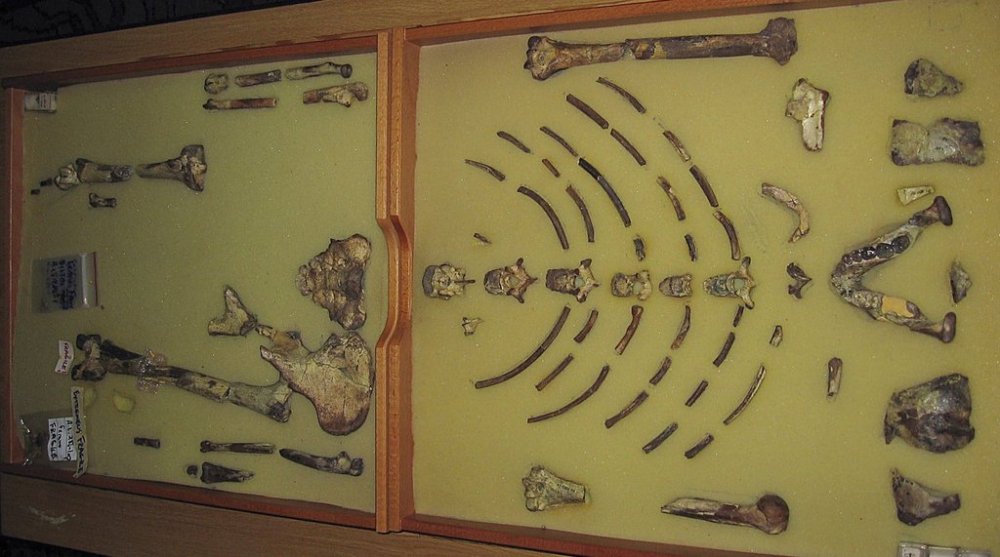Ethiopian fossil Lucy leaves for her first exhibition in Europe
Advertisement
Read this article for free:
or
Already have an account? Log in here »
To continue reading, please subscribe:
Monthly Digital Subscription
$1 per week for 24 weeks*
- Enjoy unlimited reading on winnipegfreepress.com
- Read the E-Edition, our digital replica newspaper
- Access News Break, our award-winning app
- Play interactive puzzles
*Billed as $4.00 plus GST every four weeks. After 24 weeks, price increases to the regular rate of $19.00 plus GST every four weeks. Offer available to new and qualified returning subscribers only. Cancel any time.
Monthly Digital Subscription
$4.75/week*
- Enjoy unlimited reading on winnipegfreepress.com
- Read the E-Edition, our digital replica newspaper
- Access News Break, our award-winning app
- Play interactive puzzles
*Billed as $19 plus GST every four weeks. Cancel any time.
To continue reading, please subscribe:
Add Free Press access to your Brandon Sun subscription for only an additional
$1 for the first 4 weeks*
*Your next subscription payment will increase by $1.00 and you will be charged $16.99 plus GST for four weeks. After four weeks, your payment will increase to $23.99 plus GST every four weeks.
Read unlimited articles for free today:
or
Already have an account? Log in here »
ADDIS ABABA, Ethiopia (AP) — The human ancestor fossil known as Lucy left Ethiopia for display in a European museum, Ethiopian national media reported Friday, citing Tourism Minister Selamawit Kassa.
Lucy’s skeleton, which is 40% complete, left Ethiopia on Friday and will be displayed at the Czech National Museum in Prague for approximately two months.
Lucy was recovered in Ethiopia in 1974 from what was an ancient lake near fossilized remains of crocodiles, turtle eggs and crab claws. She was a member of Australopithecus afarensis, an early human species that lived in Africa between about 4 million and 3 million years ago.

This is the second time Lucy has left Ethiopia. The first was in 2013, when she toured the United States.
Lucy’s fragmented bones will be exhibited alongside Selam, the fossil of an Australopithecus baby that is about 100,000 years older than Lucy and was discovered in the same region 25 years later.
“As an iconic specimen, she belongs to the whole world, so sharing her with the rest of humanity is something that everyone would love to see,” said Yohannes Haile-Selassie, Director of the Institute of Human Origins at Arizona State University.
While many experts believe Lucy’s trip to Europe presents a once-in-a-lifetime opportunity for people in Europe and beyond, there are safety concerns about the transportation of her fragile bones.
“The fragmented bones of Lucy are truly unique and need utmost care. Traveling to Europe has its own risks,” said Gidey Gebreegziabher, an archaeologist and Ph.D. candidate at the University of Warsaw, Poland, “She will also be exposed to different climate conditions, which could potentially have negative impacts on her preservation.”
Even in Ethiopia, the public has only occasionally seen the real Lucy fossil. At the National Museum of Ethiopia, a replica of Lucy is exhibited while the actual remains are stored in a secure vault.
“I’ve seen how she was packed, so I have no worries about anything happening to Lucy anymore,” Yohannes said.
Lucy’s quiet departure on Thursday night also raises questions about transparency as many Ethiopians —who take pride in her — were unaware of her journey to Europe.
“It’s unbelievable! The government appears to be deliberately sidelining its people from the narrative of their own heritage,” Gebreegziabher said.
Bekele Reta, 43, a resident who lives just 50 meters (164 feet) from the museum where Lucy is housed, was unaware of Lucy’s departure until he saw it on social media.
“I learned this morning on Facebook that Lucy has departed for Prague. It’s unfortunate that most Ethiopians only have the opportunity to see her showcased elsewhere.” he said.
Early this year, the director general of the Czech National Museum, Michal Lukeš, in a statement announcing the exhibition of Lucy and Selam, expressed his appreciation of the Ethiopians for agreeing to “lend” the remains.
“These priceless exhibits give us a unique insight into the past and deepen our understanding of humanity’s roots,” said Lukeš.

